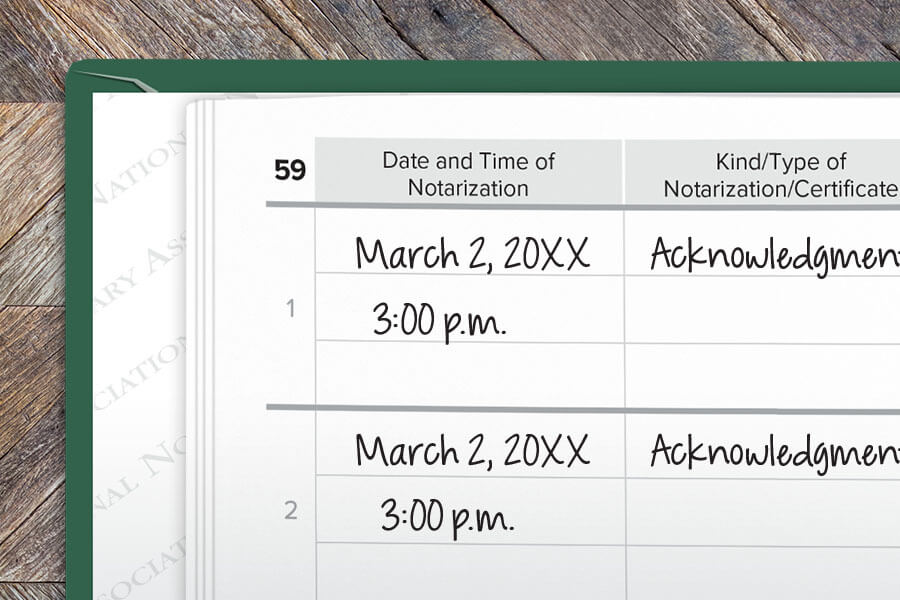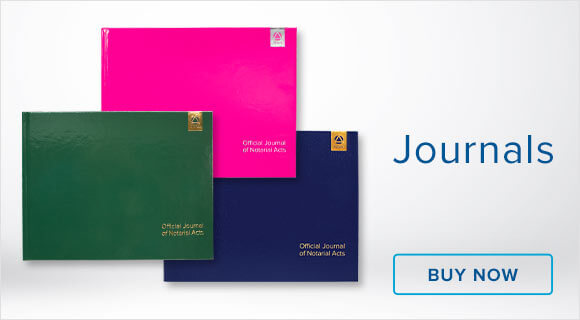
Updated 7-23-24. During a single assignment, you may be asked to notarize more than one signature or even signatures on multiple documents. When you record these notarizations in your journal, how many entries do you need to make? Also, can Notaries use ditto marks or other shortcuts when information is repeated in their journal entries?
In this article, we answer the following questions:
- Can I use ditto marks in my Notary journal?
- Can I record multiple documents in one journal entry?
Can I use ditto marks in my Notary journal?
Ditto marks can seem like an obvious shortcut when recording the same information for multiple notarizations performed at the same time. But using them depends on your state’s requirements.
The tips in this article apply specifically to journals that are designed for the information in a single entry to span two facing pages. The NNA’s journal is a good example of this.
California journal requirements are very strict — the Secretary of State requires Notaries to complete a full journal entry for each notarization performed. California Notaries may not use ditto marks for journal entries. The reason for this is California Notaries are required by law to provide copies of information in their journals to the public upon a written request, and any line item provided must include complete information.
Hawaii's Notary Public Manual states journal entries must be created “at length.” This would also preclude Hawaii Notaries from using ditto marks or other shortcuts in their journals.
Illinois permits its Notaries to abbreviate journal entry information when a Notary performs multiple notarizations for the same principal during a single transaction. However, all information required by Illinois law must be recorded in the initial journal entry, and any abbreviated entries must include the type of transaction and the number of documents notarized for the principal as part of the single transaction (IAC 176.920 f); see also IAC 176.930 f)).
Texas allows a Notary Public who performs multiple notarizations for the same signer within a single document to abbreviate the entry of those notarizations in the Notary record book, except that a separate entry must be made for each type of notarial act. The abbreviated entry must contain all the information required by §406.014, Government Code, and must include the number of notarizations performed within the specified document (1 TAC 87.51[c]).
If you are commissioned in a state that does not provide guidance about journal shortcuts or does not require keeping a journal for traditional pen-and-paper notarizations such as Florida, it’s up to you whether to use ditto marks. At a minimum, the NNA recommends always filling out the first entry on each page completely, and only using ditto or hash marks for duplicate information for subsequent entries on the same page.
Can I record multiple documents in one journal entry?
When notarizing multiple documents for a single signer, many Notaries ask if they can combine information from all the documents into a single Notary journal entry. Again, this depends on state law.
Arizona and Nevada permit Notaries to group information about multiple notarizations performed into a single journal entry if the notarizations were performed for the same signer or on similar documents at the same time. Other states, such as California, Hawaii and Pennsylvania, require a separate, complete entry for each individual notarization.
In states that do not say one way or the other, the NNA recommends making a separate entry for each notarial act, but using ditto marks as described above. This helps keep the information in your journal easy to read while cutting down on the work required to create multiple entries.
David Thun is the Editorial Manager at the National Notary Association.


Related Articles:
What every Notary needs to know about journals
Who may ask to see a Notary Signing Agent’s journal entries?
What to do if your Notary seal or journal goes missing